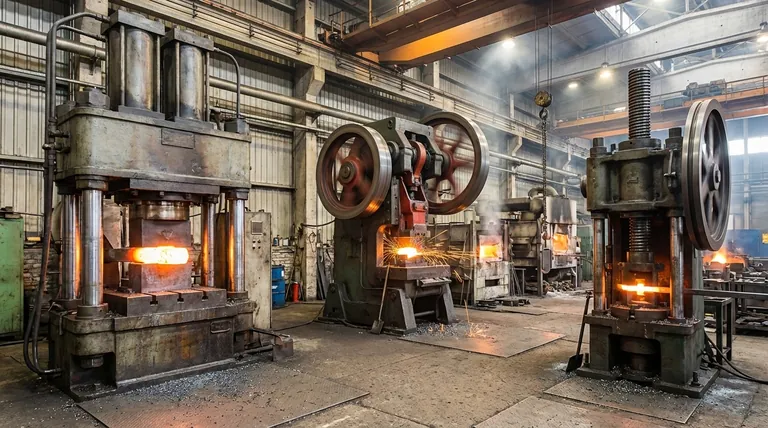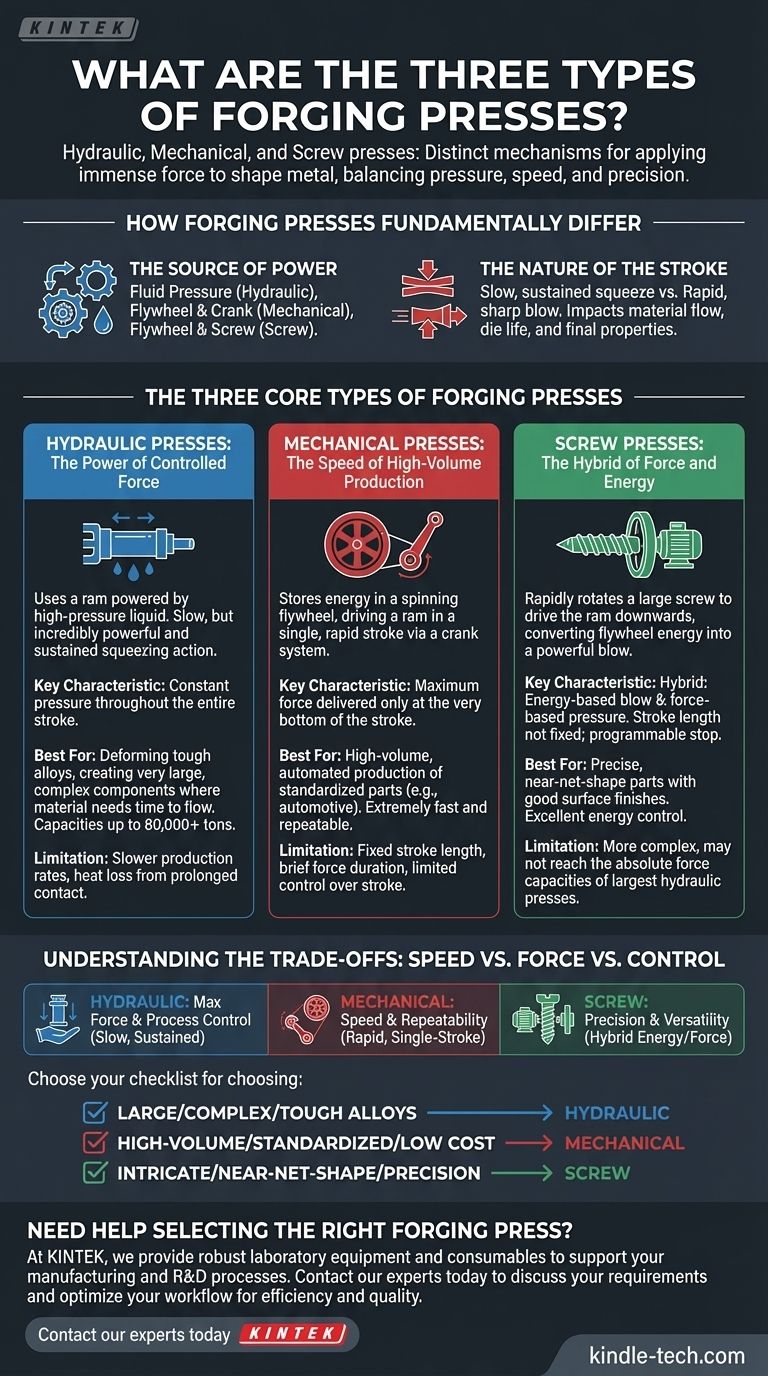The three primary types of forging presses are hydraulic, mechanical, and screw presses. Each uses a distinct mechanism to apply the immense force required to shape metal, making them suitable for different applications, production volumes, and material types.
The critical difference between forging presses is not simply how much force they can generate, but how that force is delivered. The choice between press types hinges on balancing the need for controlled pressure, high-speed production, or a hybrid of energy and precision.

How Forging Presses Fundamentally Differ
All forging presses work to deform metal billets, but the method of force application dictates their best use. The two key variables are the source of energy and the characteristics of the press stroke.
The Source of Power
A press's power source determines its speed and control. Hydraulic presses use fluid pressure, mechanical presses use a flywheel and crank system, and screw presses use a flywheel to drive a screw.
The Nature of the Stroke
The stroke—the movement of the die—defines the forging process. Some presses deliver a slow, sustained squeeze, while others provide a rapid, sharp blow. This has a significant impact on material flow, die life, and the final part's properties.
The Three Core Types of Forging Presses
Understanding each type's mechanism reveals its strengths and weaknesses.
Hydraulic Presses: The Power of Controlled Force
Hydraulic presses use a ram powered by high-pressure liquid. This mechanism allows for a relatively slow but incredibly powerful and sustained squeezing action.
This constant pressure is applied throughout the entire stroke. This makes hydraulic presses ideal for deforming tough alloys or creating very large, complex components where the material needs time to flow into the die cavity.
As noted, capacities can be massive, ranging from 200 tons for open die forging to over 80,000 tons for impression die forging, enabling the creation of huge aerospace and industrial parts.
Mechanical Presses: The Speed of High-Volume Production
Mechanical presses store energy in a large, spinning flywheel. When activated, a clutch connects the flywheel to a crank or eccentric shaft, which drives the ram down in a single, rapid stroke.
This design delivers maximum force only at the very bottom of the stroke. Mechanical presses are extremely fast and repeatable, making them the standard for high-volume, automated production of parts like automotive components.
Their limitation is the fixed stroke length and the brief duration of force application, which is less suitable for materials requiring a slow, controlled deformation.
Screw Presses: The Hybrid of Force and Energy
Screw presses bridge the gap between hydraulic and mechanical designs. They use a motor and flywheel to rapidly rotate a large screw, which drives the ram downwards.
The energy from the flywheel is converted into a powerful blow when the die makes contact. Unlike a mechanical press, the stroke length is not fixed; the ram can be programmed to stop based on position or force.
This gives screw presses characteristics of both a hammer (energy-based blow) and a press (force-based pressure), offering excellent control for producing precise, near-net-shape parts with good surface finishes.
Understanding the Trade-offs: Speed vs. Force vs. Control
No single press type is universally superior. The optimal choice is always a trade-off between the desired outcome and the machine's capabilities.
Where Each Press Excels
- Hydraulic Press: Unmatched for maximum force and process control. Its slow, sustained squeeze is perfect for large parts and hard-to-forge alloys.
- Mechanical Press: Unbeatable for speed and repeatability. It is the engine of high-volume manufacturing for standardized parts.
- Screw Press: Excels in precision and versatility. It offers excellent energy control, making it ideal for complex, near-net-shape forgings.
Key Limitations to Consider
- Hydraulic Press: Significantly slower production rates compared to mechanical presses. The prolonged contact time can also lead to heat loss in the workpiece and increased die wear.
- Mechanical Press: Limited force is available at the top of the stroke, and the operator has little control over the stroke length or speed once it is initiated.
- Screw Press: Can be more complex and expensive than a comparable mechanical press, and it may not reach the absolute force capacities of the largest hydraulic presses.
Choosing the Right Press for the Application
Your final decision should be driven entirely by the part's design, material, and required production volume.
- If your primary focus is forging very large, complex parts from high-strength alloys: A hydraulic press offers the necessary force and controlled deformation.
- If your primary focus is mass-producing smaller, standardized parts at the lowest possible cost: A mechanical press provides the essential speed and efficiency.
- If your primary focus is producing intricate, near-net-shape parts with high precision and a good surface finish: A screw press delivers the required balance of energy, control, and versatility.
Ultimately, selecting the correct forging equipment is about matching the machine's distinct physical capabilities to the specific metallurgical needs of your project.
Summary Table:
| Press Type | Power Source | Key Characteristic | Best For |
|---|---|---|---|
| Hydraulic Press | Fluid Pressure | Slow, sustained squeeze with maximum force | Large, complex parts; tough alloys |
| Mechanical Press | Flywheel & Crank | Rapid, single-stroke for high-speed production | High-volume, standardized parts |
| Screw Press | Flywheel & Screw | Hybrid energy/force control for precision | Intricate, near-net-shape parts |
Need help selecting the right forging press for your specific application?
At KINTEK, we specialize in providing robust laboratory equipment and consumables to support your manufacturing and R&D processes. Whether you're forging high-strength alloys or producing precision components, our expertise can help you optimize your workflow for maximum efficiency and quality.
Contact our experts today to discuss your project requirements and discover how KINTEK's solutions can enhance your forging operations.
Visual Guide

Related Products
- Laboratory Hydraulic Press Lab Pellet Press Machine for Glove Box
- Laboratory Hydraulic Press Split Electric Lab Pellet Press
- 24T 30T 60T Heated Hydraulic Press Machine with Heated Plates for Laboratory Hot Press
- Manual High Temperature Heated Hydraulic Press Machine with Heated Plates for Lab
- Heated Hydraulic Press Machine with Heated Plates for Vacuum Box Laboratory Hot Press
People Also Ask
- Why KBr pellets are used to prepare solid samples in FTIR? Achieve Clear, Reliable Solid Analysis
- Which one of the following is used to prepare sample pellet in IR spectroscopy? Potassium Bromide (KBr) Explained
- How much pressure can a hydraulic press make? From 1 Ton to 75,000+ Tons of Force
- Why use KBr for IR? Achieve Clear, Unobstructed Spectra for Solid Samples
- What is the hydraulic forging process? Master the Art of High-Strength Metal Forming



















